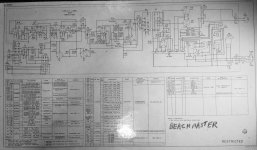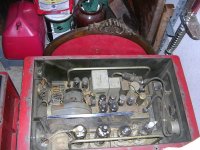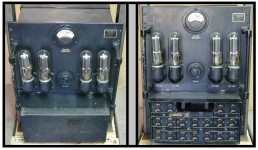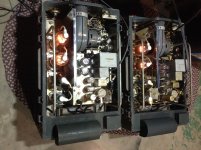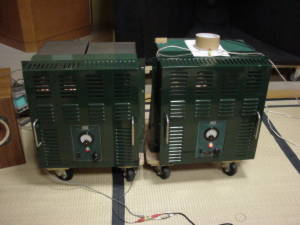Anyone ever seen one of these ? I just got done going through a pair and wow high power triodes are indeed all they are cracked up to be .
These amps sound like nothing else I ever heard even al low volume the sound open with an astounding sound stage .
Only down side they weigh 215 pounds each.
Tom
These amps sound like nothing else I ever heard even al low volume the sound open with an astounding sound stage .
Only down side they weigh 215 pounds each.
Tom
Attachments
The pair of 6V6's isn't triode-strapped... 
Triodes are great if you can drive the hell out of the grids. Then they look like tetrodes. In this case, they're driving them in zero bias, not necessarily class B but that's the familiar example, "zero bias class B". Most transmitter tubes were made this way: fairly high mu with very little grid current in the positive region, giving tons of power output for a modest input. The 6V6s are doing real work, but still a small fraction of the total output.
Filtering is quite light (as such oldies tended to be), so I wouldn't be surprised if that thing has a lot of hum. But it's mostly PP where it matters, so it'll mostly be nulled out.
Tim
Triodes are great if you can drive the hell out of the grids. Then they look like tetrodes. In this case, they're driving them in zero bias, not necessarily class B but that's the familiar example, "zero bias class B". Most transmitter tubes were made this way: fairly high mu with very little grid current in the positive region, giving tons of power output for a modest input. The 6V6s are doing real work, but still a small fraction of the total output.
Filtering is quite light (as such oldies tended to be), so I wouldn't be surprised if that thing has a lot of hum. But it's mostly PP where it matters, so it'll mostly be nulled out.
Tim
Do you really need all that power? If not, you may want to re-bias it for more class A output.These amps sound like nothing else I ever heard even al low volume the sound open with an astounding sound stage .
Do you really need all that power? If not, you may want to re-bias it for more class A output.
805s aren't good for class A1, the u-factor is too high. They do work well in class A2 though, with a lowering of the B+ voltage. These triodes lose their "magic" when not driven into grid current. They need to be driven hard with a low impedance driver to sound best.
There was an article in Sound Practices or Glass Audio or was it VTV years ago that had the Altec 287 in an article. The 287 is Altec's version of the Beachmaster; same basic circuit, IIRC. A lady engineer had acquired a pair and restored them.
I really love the sound of higher mu power triodes driven in class A2; they have all the advantages of triodes in class A1 but with MUCH more power at hand. Great sound!
No one suggested class A1... Class AB1 would be a small improvement over class B.805s aren't good for class A1, the u-factor is too high.
Altec 287W used the 805 output tubes, while the 287 used 845. the Beachmaster probably pre-dated the Altec's by a few years, as it was made for the Arm Forces during WWII. All of these amplifiers have push-pull output stages, and operate in either Class B or Class AB1 (with very little "A") given the high output power required. They would not be considered hi-fi without some modifications...The 287 is Altec's version of the Beachmaster; same basic circuit, IIRC. A lady engineer had acquired a pair and restored them.
I really love the sound of higher mu power triodes driven in class A2; they have all the advantages of triodes in class A1 but with MUCH more power at hand. Great sound!
You'd have to work at getting the 805 into class B, so you typically end up in AB. Given that a watt or two of class A is more class A than many small triode amps manage, or look at it as a significant percentage of a 5-10watt triode amp, not sure what the problem is? Think of it as a 1-5watt class A amp without the prospect of ever clipping?? 
Whatever floats your boat...In terms of Class A output, these amps would rank as some of the most in-efficient amps around.
Want a free cheese? Take it in a mousetrap.
Everything is in optimization, nothing is absolute.
I have done work on a few Altec 1570bs and also run push-pull 811As at times.
It would be my first amp of choice if I ran low efficiency speakers.
Running horns and 845s though.
If you got rid of the tube rectifiers on an 1570, the power consumption is not much higher than a typical mosfet amp. Also I can say the 1570 will run for years and they are still in use in some places.
It would be my first amp of choice if I ran low efficiency speakers.
Running horns and 845s though.
If you got rid of the tube rectifiers on an 1570, the power consumption is not much higher than a typical mosfet amp. Also I can say the 1570 will run for years and they are still in use in some places.
I like this one that uses 811As in class A2; a really great sounding amp:
http://www.technicalaudio.com/pdf/G...Audio_Developments_feedback_cutter_system.pdf
The output transformer is 6.6K so the parts are easy to source to make a clone/homebrew version.
http://www.technicalaudio.com/pdf/G...Audio_Developments_feedback_cutter_system.pdf
The output transformer is 6.6K so the parts are easy to source to make a clone/homebrew version.
- Status
- This old topic is closed. If you want to reopen this topic, contact a moderator using the "Report Post" button.
- Home
- Amplifiers
- Tubes / Valves
- All triode 250 watt western electric
